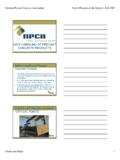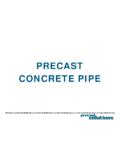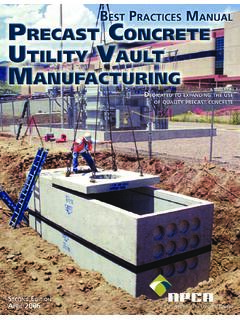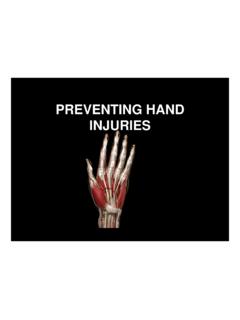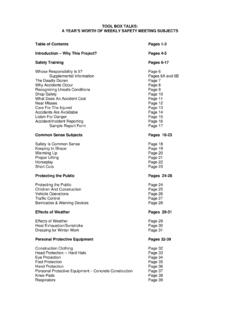Transcription of Fixed and Portable Ladders- A Guide to OSHA Rules
1 Fixed and Portable Ladders- A Guide to OSHA Rules Introduction Working on and around stairways and ladders is hazardous. stairways and ladders are major sources of injuries and fatalities among construction workers for example, and many of the injuries are serious enough to require time off the job. OSHA Rules apply to all stairways and ladders used in construction, alteration, repair, painting, decorating and demolition of worksites covered by OSHA's construction safety and health standards. General Requirements These Rules specify when employers must provide stairways and ladders . In general, the standards require the following: When there is a break in elevation of 19 inches (48. cm) or more and no ramp, runway, embankment or personnel hoist is available, employers must provide a stairway or ladder at all worker points of access. General Requirements These Rules specify when employers must provide stairways and ladders . In general, the standards require the following: When there is only one point of access between levels, employers must keep it clear of obstacles to permit free passage by workers.
2 If free passage becomes restricted, employers must provide a second point of access and ensure that workers use it. General Requirements These Rules specify when employers must provide stairways and ladders . In general, the standards require the following: When there are more than two points of access between levels, employers must ensure that at least one point of access remains clear. General Requirements In addition, employers must install all stairway and ladder fall protection systems required by these Rules and ensure that their worksite meets all requirements of the stairway and ladder Rules before employees use stairways or ladders. See 29 CFR for the details of the standard. Note: The standard does not apply to ladders specifically manufactured for scaffold access and egress, but does apply to job- made and manufactured Portable ladders intended for general purpose use. Rules for ladders used on or with scaffolds are addressed in 29 CFR Subpart L. Rules for Ladders The following Rules apply to all ladders: Maintain ladders free of oil, grease and other slipping hazards.
3 Do not load ladders beyond their maximum intended load nor beyond their manufacturer's rated capacity. Use ladders only for their designed purpose. Rules for Ladders The following Rules apply to all ladders: Use ladders only on stable and level surfaces unless secured to prevent accidental movement. Do not use ladders on slippery surfaces unless secured or provided with slip-resistant feet to prevent accidental movement. Do not use slip resistant feet as a substitute for exercising care when placing, lashing or holding a ladder upon slippery surfaces. Rules for Ladders The following Rules apply to all ladders: Secure ladders placed in areas such as passageways, doorways or driveways, or where they can be displaced by workplace activities or traffic to prevent accidental movement. Or use a barricade to keep traffic or activity away from the ladder . Keep areas clear around the top and bottom of ladders. Rules for Ladders The following Rules apply to all ladders: Do not move, shift or extend ladders while in use.
4 Use ladders equipped with nonconductive side rails if the worker or the ladder could contact exposed energized electrical equipment. Face the ladder when moving up or down. Use at least one hand to grasp the ladder when climbing. Do not carry objects or loads Rules for Ladders In addition, the following general requirements apply to all ladders, including ladders built at the jobsite: Double-cleated ladders or two or more ladders must be provided when ladders are the only way to enter or exit a work area where 25 or more employees work or when a ladder serves simultaneous two-way traffic. ladder rungs, cleats and steps must be parallel, level and uniformly spaced when the ladder is in position for use. Rules for Ladders In addition, the following general requirements apply to all ladders, including ladders built at the jobsite: Rungs, cleats and steps of Portable and Fixed ladders (except as provided below) must not be spaced less than 10 inches (25 cm) apart, not more than 14 inches (36 cm) apart, along the ladder 's side rails.
5 Rungs, cleats and steps of step stools must not be less than 8 inches (20 cm) apart, nor more than 12. inches (31 cm) apart, between center lines of the rungs, cleats and steps. Rules for Ladders In addition, the following general requirements apply to all ladders, including ladders built at the jobsite: Rungs, cleats and steps at the base section of extension trestle ladders must not be less than 8. inches (20 cm) nor more than 18 inches (46cm). apart, between center lines of the rungs, cleats and steps. The rung spacing on the extension section must not be less than 6 inches (15 cm) nor more than 12 inches (31 cm). Rules for Ladders In addition, the following general requirements apply to all ladders, including ladders built at the jobsite: Ladders must not be tied or fastened together to create longer sections unless they are specifically designed for such use. When splicing side rails, the resulting side rail must be equivalent in strength to a one-piece side rail made of the same material.
6 Rules for Ladders In addition, the following general requirements apply to all ladders, including ladders built at the jobsite: Two or more separate ladders used to reach an elevated work area must be offset with a platform or landing between the ladders, except when Portable ladders are used to gain access to Fixed ladders. Rules for Ladders In addition, the following general requirements apply to all ladders, including ladders built at the jobsite: ladder components must be surfaced to prevent snagging of clothing and injury from punctures or lacerations. Wood ladders must not be coated with any opaque covering except for identification or warning labels, which may be placed only on one face of a side rail. A competent person must inspect ladders for visible defects periodically and after any incident that could affect their safe use. Specific Types of Ladders Do not use single-rail ladders. Use non-self-supporting ladders at an angle where the horizontal distance from the top support to the foot of the ladder is approximately one-quarter of the working length of the ladder .
7 Specific Types of Ladders Use wooden ladders built at the jobsite with spliced side rails at an angle where the horizontal distance is one- eighth of the working length of the ladder . In addition, the top of a non-self-supporting ladder must be placed with two rails supported equally unless it is equipped with a single support attachment. Stepladders Do not use the top or top step of a stepladder as a step. Do not use cross bracing on the rear section of stepladders for climbing unless the ladders are designed and provided with steps for climbing on both front and rear sections. Metal spreader or locking devices must be provided on stepladders to hold the front and back sections in an open position when ladders are being used. Portable Ladders The minimum clear distance between side rails for all Portable ladders must be inches (29 cm). In addition, the rungs and steps of Portable metal ladders must be corrugated, knurled, dimpled, coated with skid- resistant material or treated to minimize slipping.
8 Portable Ladders Non-self-supporting and self-supporting Portable ladders must support at least four times the maximum intended load; extra heavy-duty type 1A metal or plastic ladders must sustain times the maximum intended load. To determine whether a self-supporting ladder can sustain a certain load, apply the load to the ladder in a downward vertical direction with the ladder placed at a horizontal angle of degrees Portable Ladders When Portable ladders are used for access to an upper landing surface, the side rails must extend at least 3 feet (.9 m) above the upper landing surface. When such an extension is not possible, the ladder must be secured and a grasping device such as a grab rail must be provided to assist workers in mounting and dismounting the ladder . A ladder extension must not deflect under a load that would cause the ladder to slip off its supports. Fixed Ladders If the total length of the climb on a Fixed ladder equals or exceeds 24 feet ( m), the ladder must be equipped with ladder safety devices; or self-retracting lifelines and rest platforms at intervals not to exceed 150 feet ( m); or a cage or well and multiple ladder sections with each ladder section not to exceed 50 feet ( m) in length.
9 Fixed Ladders These ladder sections must be offset from adjacent sections and landing platforms must be provided at maximum intervals of 50 feet ( m). In addition, Fixed ladders must meet the following requirements: Fixed Ladders Fixed ladders must be able to support at least two loads of 250 pounds (114 kg) each, concentrated between any two consecutive attachments. Fixed ladders also must support added anticipated loads caused by ice buildup, winds, rigging and impact loads resulting from using ladder safety devices. Fixed Ladders Individual rung/step ladders must extend at least 42. inches ( m) above an access level or landing platform either by the continuation of the rung spacings as horizontal grab bars or by providing vertical grab bars that must have the same lateral spacing as the vertical legs of the ladder rails. Fixed Ladders Each step or rung of a Fixed ladder must be able to support a load of at least 250 pounds (114 kg) applied in the middle of the step or rung. Minimum clear distance between the sides of individual rung/step ladders and between the side rails of other Fixed ladders must be 16 inches (41 cm).
10 Fixed Ladders Rungs of individual rung/step ladders must be shaped to prevent slipping off the end of the rungs. Rungs and steps of Fixed metal ladders manufactured after March 15, 1991, must be corrugated, knurled, dimpled, coated with skid-resistant material or treated to minimize slipping. Minimum perpendicular clearance between Fixed ladder rungs, cleats, and steps and any obstruction behind the ladder must be 7 inches (18 cm), except that the clearance for an elevator pit ladder must be inches (11 cm). Fixed Ladders Minimum perpendicular clearance between the centerline of Fixed ladder rungs, cleats and steps, and any obstruction on the climbing side of the ladder must be 30. inches (76 cm). If obstructions are unavoidable, clearance may be reduced to 24 inches (61 cm), provided a deflection device is installed to Guide workers around the obstruction. Fixed Ladders Step-across distance between the center of the steps or rungs of Fixed ladders and the nearest edge of a landing area must be no less than 7 inches (18 cm) and no more than 12 inches (30 cm).
